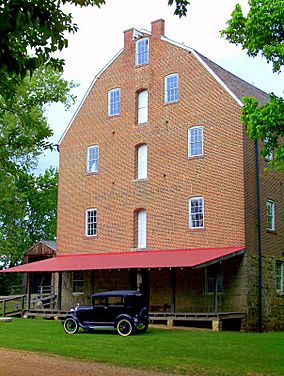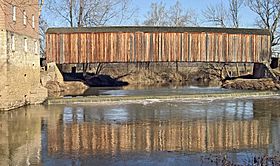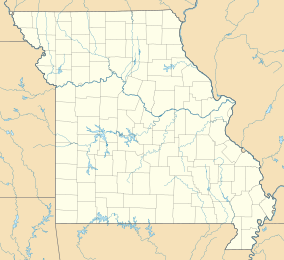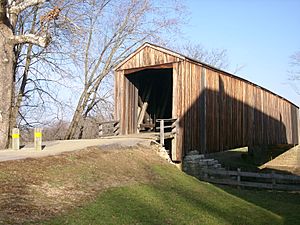Bollinger Mill State Historic Site facts for kids
Quick facts for kids Bollinger Mill State Historic Site |
|
|---|---|
 |
|
| Location | Burfordville, Cape Girardeau County, Missouri, United States |
| Area | 43.85 acres (17.75 ha) |
| Established | 1967 |
| Visitors | 48,900 (in 2022) |
| Governing body | Missouri Department of Natural Resources |
| Website | Bollinger Mill State Historic Site |
|
Burfordville Covered Bridge
|
|
 |
|
| Built | 1858–1868 |
| Built by | Joseph Lansmon |
| NRHP reference No. | 70000325 |
| Added to NRHP | May 19, 1970 |
|
Burfordville Mill
|
|
| Built | 1825; 1867 |
| NRHP reference No. | 71000463 |
| Added to NRHP | May 27, 1971 |
The Bollinger Mill State Historic Site is a cool place in Missouri. It has an old mill and a covered bridge. These buildings were built even before the American Civil War! The site is in Burfordville, Cape Girardeau County.
This special park opened in 1967. You can take tours of the mill and have picnics there. The Missouri Department of Natural Resources takes care of it. The Burfordville Covered Bridge is so important it's on the National Register of Historic Places.
Contents
Discovering Bollinger Mill's Past
The Story of Bollinger Mill
In 1797, a man named George Frederick Bollinger got a land grant from the Spanish government. He moved with his family from North Carolina to what is now Burfordville, Missouri.
Around 1800, Bollinger started building a log dam and a mill on the Whitewater River. In 1825, he rebuilt the mill and dam using strong limestone.
After Bollinger passed away in 1842, his daughter and grandsons kept the mill running. But during the Civil War, the Union army burned the mill. They did this to stop the Confederate army from getting flour and meal.
After the war, Solomon R. Burford bought the mill site. He finished building the current four-story brick mill in 1867. It stands on the same limestone foundation as the 1825 building.
Burford owned the mill until 1897. Then, the Cape County Milling Company took over. They operated the mill until 1953. Later, the Vandivort family, who were relatives of George Bollinger, bought it.
In 1961, the mill was given to the Cape Girardeau County Historical Society. Then, in 1967, it was given to the State of Missouri. The mill was added to the National Register of Historic Places in 1971.
The Burfordville Covered Bridge
Work on a bridge over the Whitewater River started in 1858. But the Civil War caused many delays. In 1868, the town of Burfordville was created, and the bridge was finished.
This makes the Burfordville bridge the oldest of the four covered bridges still standing in Missouri. Joseph Lansmon, a builder from Cape Girardeau, built it. It was part of a toll road.
The bridge is about 140 feet (43 meters) long and 12 feet (3.7 meters) wide. It has a clearance of 14 feet (4.3 meters). It's a Howe truss design, made from local yellow poplar wood.
Since it was a toll road bridge, it had a toll house on the east end. People paid a fee to cross until 1906.
Around 1900, the bridge was in bad shape. Some of its siding was missing, and the roof was partly broken. The county spent $390 to fix it in 1908. It was repaired again in 1950, when a metal roof was added.
In 1967, the same year the mill became a state property, the Missouri State Park system started taking care of the state's four remaining covered bridges. The bridge was added to the National Register of Historic Places in 1970. A year later, the park service restored it, replacing the metal roof with wooden shingles.
In 1986, the Whitewater River flooded to record levels. The water was 17 inches (43 cm) over the bridge deck! This damaged the bridge, and it had to close to cars and people.
The bridge stayed closed until 1998. After repairs to its lower parts and support timbers, it reopened for people to walk across.
Fun Things to Do at Bollinger Mill
The mill is open all year for guided tours. You can see how the original milling equipment works when the river has enough water.
The first floor of the mill also has exhibits. These show how the milling process changed over many years. The mill hosts special events, like folk music concerts. They also display old farm equipment.
The covered bridge is open all year for people to walk across and enjoy.
See Also




